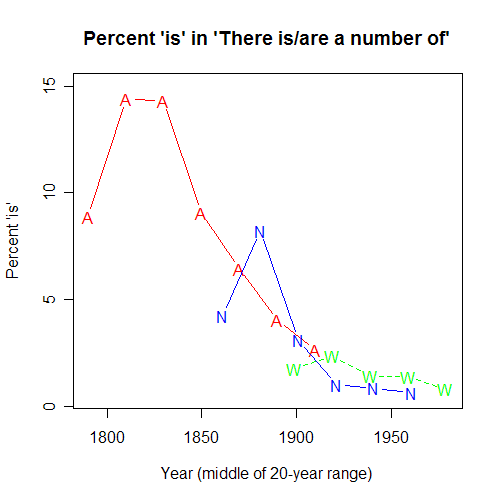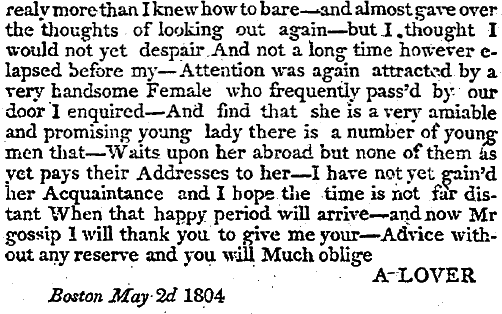January 14, 2007
"A number of" has been getting more plural since 1800
Yesterday I suggested, without much evidence, that noun phrases like "a number of Xs" have become increasingly plural over the past couple of hundred years, at least with respect to their treatment in the frame "there is/are __". For this morning's Breakfast Experiment™, I checked a couple of web-searchable sources, and the results tend to confirm my suggestion.
Between 1800 and 1840, American magazines and other periodicals used is about 14% of the time in the frame "there is/are a number of". (See the end of this post for some examples.) By the time we get to 1970 or so, publications like the New York Times and the Wall Street Journal use is less than 1% of the time in the same context. And most of the remaining uses of "is" are in quotations, like this fine example from a 1/9/2007 story by Jeff Zeleny and Carl Hulse, "Democrats Plan Symbolic Votes Against Iraq Plan":
“We believe that there is a number of Republicans who will join with us to say no to escalation,” said the Senate majority leader, Harry Reid of Nevada.
Here are the counts from the ProQuest American Periodicals Series:
| are | is | Percent is | |
| 1780-1799 | 41 |
4 |
8.9% |
| 1800-1819 | 89 |
15 |
14.4% |
| 1820-1839 | 425 |
71 |
14.3% |
| 1840-1859 | 681 |
68 |
9.1% |
| 1860-1879 | 826 |
57 |
6.5% |
| 1880-1899 | 2189 |
92 |
4.0% |
| 1900-1919 | 1890 |
51 |
2.6% |
(I started in 1780 because there were not enough examples of either sort before that.)
Here are the counts from the New York Times archive -- the archive starts on 9/18/1851, so I ran each 20-year period from 9/18 to 9/17.
| are | is | Percent is | |
| 1851-1871 | 181 |
8 |
4.2% |
| 1871-1891 | 504 |
45 |
8.2% |
| 1891-1911 | 1754 |
56 |
3.1% |
| 1911-1931 | 1660 |
17 |
1.0% |
| 1931-1951 | 1401 |
12 |
0.8% |
| 1951-1971 | 1745 |
11 |
0.6% |
And here are the counts from the Wall Street Journal. The WSJ archive starts on July 8 1889, so I ran each 20-year period from 7/8 to 7/7.
| are | is | Percent is | |
| 1889-1909 | 111 |
2 |
1.8% |
| 1909-1929 | 332 |
8 |
2.4% |
| 1929-1949 | 484 |
7 |
1.4% |
| 1949-1969 | 359 |
5 |
1.4% |
| 1969-1989 | 497 |
4 |
0.8% |
If we plot all three on the same scale, putting each point at the center of its 20-year span, and using A for the American Periodicals Series, N for the New York Times, and W for the Wall Street Journal, it looks like this:

Q.E.D.
I guess that I should plot the error bars as well, but it's kind of a pain to do that in R's plot( ) function, so I'll use the excuse that breakfast time is almost over to leave the error bars as an exercise for the reader.
This evidence raises some additional questions, whose answers are also outside the bounds of breakfast, though some of the answers may be known.
1. Was there an earlier time when singular agreement was the norm in such cases? If so, when was it? Or is singular agreement in "there is/are a number of Xs" a fashion that grew to a point and then receded?
2. There's a more general tendency to use singular agreement with there, even when the noun phrase is unambiguously plural. Thus this wise counsel from Jeff Schneider, the coach of a high school basketball team in Virginia:
“Some kids try to blame themselves, saying, ‘I should have done this or that.’ I try to tell them that there is no one thing that lost the game, rather there is many things that could have won it,” said Schneider, whose team has now lost to top rivals Potomac Falls and Broad Run in consecutive games.
Or this quotation from Richard Campbell, of Lindale, Texas, who turns out to own an illegal dumpsite ("Trashing East Texas: Land Owner Visits Acre of Dead Animals", 12/19/2006):
"There is several different tracks of property that is probably 300 acres plus," says Campbell.
Or this observation by Bobby "Blitz" Ellsworth, frontman for the thrash metal band Overkill:
That is always a blast to go over there. Every weekend there is two or three festivals.
When people like Harry Reid use singular agreement with "a number of Xs", are they they treating "a number of Xs" as singular, or are they treating it as plural but using is anyhow? (Of course, there's always the possibility that he was misquoted... And see this earlier post for a discussion of a really easy way for a copy editor to change informal speech into non-standard speech in such sentences -- just "correct" there's to there is!)
3. What's the mechanism that creates the (ubiquitous) pattern of gradual change in relative frequency over the course of centuries, well documented elsewhere and exemplified in a small way by the counts cited here?
_________________________________________________________________________________________
The first five hits for "there is a number of", APS Online, searching from 1/1/1800 onward...
"Special Manifestations of Divine Power and Grace", The New-York Missionary Magazine, 1802(3) p. 116: In another town, there is a number of open, avowed infidels.
"Amsterdam", The Boston Weekly Magazine, Nov. 20, 1802, p. 14: I went, between eleven and twelve last night, to a singular institution; by an ordinance of the government, there is a number of Bagnio houses in this town, to which women, who have no better means, are invited on the terms of a support for life.
Balance and Columbian Repository [Albany], June 14, 1803, p. 190: There is a number of brigand-barges out about different parts of the Island -- the ship May Flower, Capt. Logan, was chased close in with this port.
"Missionary Intelligence", The Massachusetts Baptist Missionary Magazine, May, 1804, p. 33: Here the cause of Zion seems to languish; yet there is a number of faithful brethren, who, I trust, will be able to stand as a bulwark against opposition.
"To The Gossip", The Boston Weekly Magazine, May 19, 1804, p. 117:

[Update: also see Sally Thomason's 9/6/2006 post "18th-Century Grammarians vs. Shakespeare et al.", which I had forgotten about.]
Posted by Mark Liberman at January 14, 2007 08:21 AM